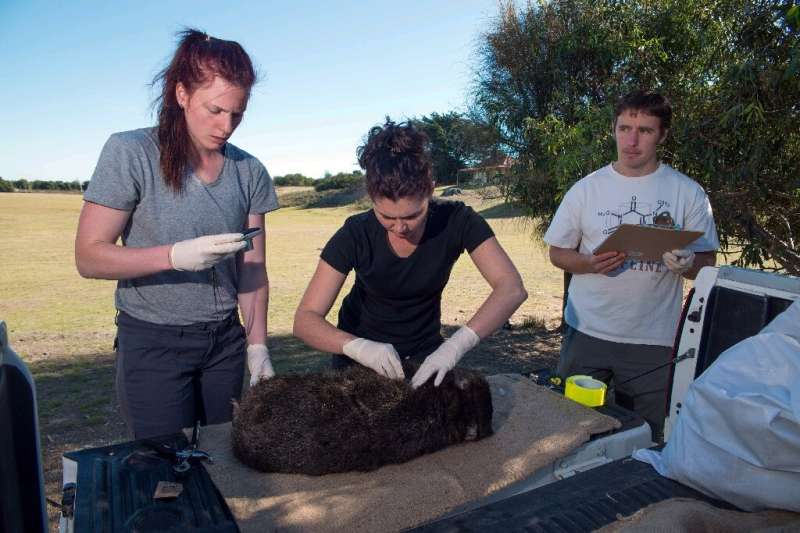Aussie drug offers hope for stamping out wombat-killing disease

A disease that has ravaged wombats in southern Australia could be brought under control using a treatment commonly applied by pet owners on cats and dogs, researchers said Wednesday.
Mange—which causes wombats to lose some or all of their fur and starve to death within months—has wiped out more than 90 percent of bare-nosed wombats in a single national park on the island state of Tasmania.
Squat and furry, wombats are small burrow-dwelling marsupials that are largely nocturnal and walk on all fours. They are not a threatened species.
But University of Tasmania scientist Scott Carver said the disease, which was introduced to Australia by European settlers in the 1800s, caused "the worst animal suffering" he had ever seen.
Mange affects wombats across much of southeastern Australia and tends to cause only scattered deaths—until an outbreak strikes an entire population.
"You get sporadic outbreaks in different locations," Carver told AFP. "When you get these outbreaks, lots of individuals die."
It is estimated there are now as few as three bare-nosed wombats left in Tasmania's Narawntapu National Park, where hundreds of the marsupials once roamed.
A paper published today in the Journal of Applied Ecology details how past attempts to control the disease in the park failed, but Carver said scientists were now "confident" a different drug—used to treat mange in domestic cats and dogs—could prove effective in wombats.
Scientists installed small doors over wombats' burrows to brush on a course of mange-fighting treatment over several months in 2015, a programme that initially seemed to eliminate mange but was deemed unsuccessful a year later once it became clear the effects were temporary.
Carver said the study had prompted researchers to turn to an alternative medication, Bravetco, that could last for up to three months after a single application, as opposed to just one week.
"It's really just a slight improvement in the duration and the delivery—if you can couple those things together it will have a great effect in controlling the disease in wombat populations," he said.
Trials of the drug on captive wombats are expected to last for the next six to 12 months, followed by at least two years of trials on wild animals.
But Carver said he was hopeful Australian regulators would approve use of Bravetco on wombats within the next 18 months, allowing wildlife carers to administer the drug.
More information: Alynn M. Martin et al, Population‐scale treatment informs solutions for control of environmentally transmitted wildlife disease, Journal of Applied Ecology (2019). DOI: 10.1111/1365-2664.13467
Journal information: Journal of Applied Ecology
© 2019 AFP


















